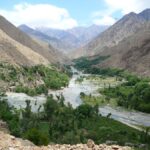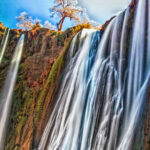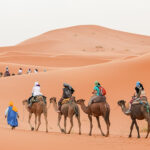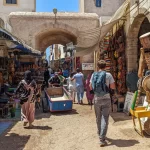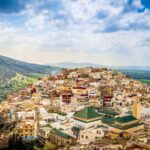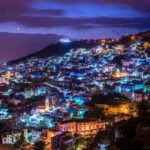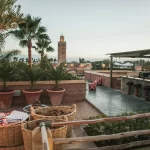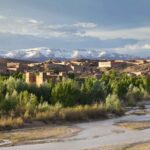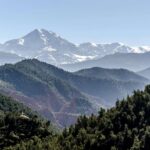Nestled in the rugged folds of the High Atlas Mountains and sweeping down to the edge of the expansive Sahara Desert, Dades Valley stands as one of Morocco’s most diverse and captivating landscapes. Known locally as the Valley of a Thousand Kasbahs, this enchanting region offers a tapestry of natural wonders and rich cultural heritage that beckons travelers seeking paths less trodden. As a jewel in Morocco’s crown, Dades Valley not only showcases the breathtaking beauty typical of the country’s famous mountain ranges but also serves as a vibrant testament to the enduring Berber traditions that have shaped its history and current way of life.
In Dades Valley, every turn on the winding roads brings you face-to-face with postcard-perfect scenes: lush palm groves stand in stark contrast against the backdrop of craggy cliffs, while ancient fortresses crumble silently atop hillsides, watching over the land as they have for centuries. The valley itself, carved deeply by the Dades River, reveals layers of geological time with its dramatically colored rock formations and steep gorges. It is this unique landscape that not only draws in nature lovers and photographers but also challenges adventurers with its many trails and hidden treasures.
But Dades Valley offers more than just visual splendor. The region is a cultural hub, a place where the Berber way of life continues with authenticity and pride. Here, visitors can immerse themselves in local traditions and experience the genuine hospitality of its people. The valley is not just a place to pass through but a destination to interact, understand, and participate in centuries-old customs that include everything from music and dance to the creation of exquisite handicrafts.

For those planning to explore Morocco, Dades Valley is an essential chapter in their travel story. This guide promises to lead you through the best that the valley has to offer—from navigating the serpentine paths of the Dades Gorges to enjoying a quiet night under the stars at a Berber camp. You’ll discover the best spots for capturing the valley’s beauty, learn about the local cuisine that is as much a cultural expression as it is nourishment, and find out how to connect with the land in a way that respects and enhances both the visitor and host experiences.
Whether you’re a first-time visitor to Morocco or a seasoned traveler eager to explore deeper, Dades Valley invites you to a world where every moment is rich with history and every landscape tells a story. Get ready to uncover the myriad attractions, engage in unique activities, and soak in the breathtaking views that await you in this less-explored enclave of Moroccan splendor. The following sections will guide you through each aspect of this remarkable valley, ensuring that your journey is as enriching as it is exhilarating.
In this article:
- Discovering Dades Valley
- Attractions in Dades Valley
- Activities in Dades Valley
- Berber Heritage and the Tribes of Dades Valley
- Strategic Role in Morocco Desert Tours
- Travel Tips for Dades Valley
- Environmental Conservation and Sustainable Tourism in Dades Valley
- Conclusion: The Enduring Allure of Dades Valley
Discovering Dades Valley
Geographical Overview:
Nestled in the eastern part of the High Atlas Mountains of Morocco, Dades Valley stretches from the cold peaks near Ouarzazate and winds its way southward to the edge of the Sahara Desert. The valley is primarily shaped by the Dades River, which meanders through the rugged landscape, nurturing a ribbon of greenery that stands in stark contrast to the stark, red rocks that flank its banks. The river’s journey begins in the High Atlas Mountains, gathering waters from the melting snows and seasonal rains, before eventually merging with the Draa River towards the desert.
The topography of the valley is a dramatic mix of towering cliffs, deep gorges, and fertile plateaus. Over millennia, the Dades River has carved out towering gorges like the famous Gorges du Dades, which boast some of the most stunning and precipitous landscapes in Morocco. The climate here varies remarkably due to the elevation changes; it can be cool and snowy in the high mountains during winter, while the lower parts of the valley experience the warm, dry conditions typical of a desert fringe.
Dades Valley is also known for its unique flora and fauna. The riverbanks are lined with lush orchards and farms, cultivating everything from figs and almonds to olives and pomegranates, thanks to the ingenious traditional irrigation systems known as ‘khettaras‘ that locals have used for centuries. Beyond agriculture, the region’s flora includes a variety of hardy shrubs and herbs that thrive in the arid climate, supporting a range of wildlife from Barbary macaques in the higher, forested areas to the elusive desert fox and numerous bird species that are crucial for bird-watchers.
Historical Context:
The history of Dades Valley is as layered as its terrain, with human activity dating back to prehistoric times. The valley’s strategic location made it a focal point for trade and human settlement, serving as a conduit between the rich trading cities of the Sahara and the northern territories of Morocco. Berber tribes, the indigenous people of this area, have been the custodians of the valley for centuries, developing a culture that is deeply intertwined with the landscape.
During the medieval period, Dades Valley became an important node in the trans-Saharan trade routes. Caravans laden with gold, salt, and other precious commodities would pass through, contributing to the flourishing of local communities and the construction of many kasbahs and ksours (fortified villages) that dot the landscape. These structures, built primarily from mud-brick, are a testament to the ingenuity of the Berber architectural style, designed to withstand the harsh climate while providing fortification against invaders.
In the more recent history, the valley experienced a blend of conflict and cooperation under successive waves of Arab, and French control, each leaving its mark on the culture and governance of the region. Post-independence, Dades Valley has seen significant changes with the introduction of modern infrastructure, yet the impact of centuries-old trade dynamics still resonates in the bustling markets and in the traditional crafts and techniques passed down through generations.
The influence of historical trade routes on the valley’s development is evident not only in the cultural melting pot that characterizes the area but also in the continued importance of Dades as a commercial and cultural link within Morocco. The old routes are now popular with tourists, who trek the same paths once used by traders and explorers, adding a layer of economic development shaped by international interest in the region’s heritage.
Exploring Dades Valley is akin to walking through a living museum, where every path tells a story of geological marvels and every village narrates tales of a rich, storied past. Whether it’s the natural splendor of the landscapes, the warmth of its people, or the echoes of its history, Dades Valley offers a journey that is as profound as it is picturesque.
Attractions in Dades Valley
Dades Gorges:
One of the most dramatic and visited sites in Dades Valley is the Dades Gorges. Towering over the valley floor, these gorges are a breathtaking spectacle of natural beauty and geological wonder. Carved by the Dades River over millions of years, the gorges showcase a stunning array of colors and formations, ranging from deep red to dusty pink, which change hue as the sun travels across the sky. The gorge, reminiscent of a prehistoric era, features canyon walls that soar over 400 metres high—surpassing the Empire State Building. As one of Morocco’s prime destinations, it attracts photographers, climbers, bikers, and hikers.

The geology of Dades Gorges reveals layers of history, with each stratum telling a story of the Earth’s past climates and ecosystems. The cliffs are primarily composed of limestone and marl, materials that were deposited when the area was covered by sea millions of years ago. Erosion by water, wind, and tectonic movements sculpted these materials into the dramatic cliffs and ravines we see today.
For visitors, the experience of walking through the gorges is like stepping into a colossal natural cathedral. The walls of the gorge rise steeply, creating a cool microclimate within, a respite from the Moroccan heat. A road winds through the gorges, offering various stops where travelers can admire the views, take photos, or start a hike. Several walking paths, ranging from easy strolls to challenging hikes, allow visitors to explore the gorges at their own pace.
Conservation efforts are crucial in preserving the beauty and natural integrity of the Dades Gorges. The local community, along with environmental organizations, works to protect this unique ecosystem from the pressures of tourism and climate change. Visitors are encouraged to respect the natural environment by sticking to marked trails, refraining from littering, and avoiding the disturbance of local wildlife. Responsible tourism ensures that the gorges remain a pristine and inspiring destination for future generations.
Unique Geological Formations: Monkey Fingers and More:
Apart from the gorges, Dades Valley is renowned for its unique geological formations, such as the ‘Monkey Fingers’. These peculiar rock structures look like thin, elongated fingers reaching up towards the sky, created by the erosion of soft rock while the harder rock remains standing. The best times to photograph these stunning formations are during the early morning or late afternoon when the light casts long shadows and the orange glow of the sun accentuates their contours.
Exploring the Monkey Fingers and other formations offers a glimpse into the natural forces that shape our world. These formations are primarily made of sedimentary rock, laid down by ancient rivers and seas and later sculpted by wind and water erosion. Their unusual shapes not only provide spectacular visuals but also tell tales of geological processes that have taken place over millions of years.

Cultural Sites and Berber Villages: Aït Oudinar and Beyond:
Dades Valley is also a tapestry of rich cultural heritage, most notably seen in its Berber villages like Aït Oudinar. These villages are a profound reflection of the indigenous Berber (Amazigh) culture that has thrived in Morocco’s Atlas regions for millennia. Aït Oudinar, for example, is characterized by its traditional mudbrick homes that blend seamlessly into the mountainous landscape and its lush gardens nourished by sophisticated ancient irrigation systems.
A visit to Aït Oudinar offers an intimate glimpse into the daily lives of the Berber people. The architecture here is particularly fascinating, designed not only for defense against invaders but also for managing the harsh climatic conditions. Thick walls provide insulation, and narrow streets create shaded pathways. The community’s lifestyle is a blend of age-old traditions and modern influences, where ancient farming techniques coexist with contemporary amenities brought by solar power and mobile connectivity.
The cultural significance of these villages is immense, as they are the custodians of the Berber heritage in Morocco. Traditional music, dance, and crafts are still part of everyday life, and many villagers are keen to share their customs with respectful visitors. Engaging with the local community, perhaps through a guided tour or a homestay, provides deeper insight into a way of life that has sustained generations.
Preserving the Cultural Tapestry:
Preservation efforts in these villages focus not only on maintaining physical structures but also on keeping the intangible heritage alive. This includes the Berber language, Tamazight, which has seen a revival in recent years through educational and cultural initiatives. Visitors can contribute to these efforts by participating in cultural exchanges that respect and honor local traditions and by supporting local artisans through the purchase of authentic handicrafts.
Exploring the attractions of Dades Valley offers more than just a travel experience; it is an expedition into the heart of Morocco’s natural and cultural landscapes. From the awe-inspiring Dades Gorges to the unique geological formations and the vibrant Berber villages, Dades Valley invites travelers to connect with a world that moves at the rhythm of nature and thrives on the preservation of its heritage.

Activities in Dades Valley
Dades Valley, with its rugged landscapes and rich cultural tapestry, offers an array of activities that can satisfy the adventure seeker, the food lover, and the culture enthusiast alike. Here’s how you can immerse yourself fully in what the valley has to offer.
Adventure and Recreation:
For those drawn to the great outdoors, Dades Valley is nothing short of a playground. The diverse terrain invites a variety of exhilarating activities:
• Hiking: There are numerous trails crisscrossing the valley, catering to all levels of hikers. From leisurely walks through lush orchards to more strenuous treks up steep gorges, the hiking paths offer majestic views and intimate encounters with the valley’s natural wonders. Notable trails include the path through the Monkey Fingers rock formations and the trek to the nomad caves above Aït Oudinar, where panoramic views reward your efforts.
• Rock Climbing: The towering cliffs of the Dades Gorges provide excellent opportunities for rock climbing. Enthusiasts will find both challenging and beginner-friendly routes, with the limestone and sandstone formations offering good grip. Local guides and outfitters can provide equipment and lead climbs, ensuring safety and an enjoyable experience for all skill levels.
• River Trekking: Following the Dades River as it winds through the valley can be a remarkable adventure. This activity is particularly refreshing during the warmer months and offers a unique perspective of the valley’s geography and ecosystems.

When organizing these activities, it’s important to connect with local adventure sports providers who not only know the terrain but also prioritize safety. Reliable providers will offer gear that meets safety standards and guides who are trained in first aid and rescue techniques. Always check the weather conditions before setting out, as sudden changes can affect the safety of outdoor activities.
Culinary Journey:
Dades Valley is also a destination for culinary explorers. The valley’s cuisine reflects the rich agricultural bounty and the Berber culinary traditions:
• Must-Try Dishes: Start with the Berber omelet, a flavorful mixture of eggs, tomatoes, and spices, cooked over an open fire. Tagines in the valley are particularly delicious, slow-cooked with locally sourced vegetables and meat, and often enhanced with fruits like dates or apricots. For a unique local experience, try the medfouna, sometimes called ‘Berber pizza,’ a stuffed bread that is a feast in itself.
• Local Restaurants: From roadside stalls to family-run guesthouses, the options for authentic dining are abundant. Kasbah Aït Arbi has a reputation for its traditional dishes and welcoming atmosphere, while Chez Pierre offers a blend of French and Moroccan cuisine with stunning views of the valley.
• Profiles of Local Chefs: Many kitchens in Dades Valley are helmed by chefs who are guardians of their culinary heritage while also innovating with available resources. For example, Chef Laila at La Perle du Dades passionately incorporates organic local produce into her dishes, creating a farm-to-table experience that connects diners with the land in a very tangible way.
Cultural Experiences:
The cultural fabric of Dades Valley is woven through its markets, festivals, and daily interactions with the locals:
• Markets and Festivals: Visiting a local souk offers insights into the everyday life of the valley’s residents. The market in Boumalne Dades, held on Tuesdays, is a vibrant mix of colors, scents, and sounds where everything from spices to handicrafts is traded. Seasonal festivals add to the region’s charm, notably the Rose Festival in nearby El Kelaa M’Gouna. This renowned festival celebrates local agriculture and crafts with music, dancing, and a festive atmosphere, drawing visitors from around the globe to experience the unique culture and beauty of the Dades Valley.
• Immersive Experiences: For those interested in a deeper cultural immersion, participating in a cooking class or a craft workshop can be enlightening. These activities not only provide a hands-on way to learn about Berber culture but also support the local economy. Additionally, many local guesthouses offer evening programs featuring traditional music and dance, providing a delightful glimpse into the artistic heritage of the valley.
Exploring Dades Valley through these activities allows visitors to engage with the region in a meaningful way. Whether scaling the rugged cliffs, savoring the flavors of the local cuisine, or celebrating at a Berber festival, the experiences gathered here are sure to enrich your travel story and provide lasting memories of this spectacular Moroccan valley.
Berber Heritage and the Tribes of Dades Valley
Nestled amidst the rugged terrain of the High Atlas Mountains, Dades Valley is not just a geographical marvel; it is also a cradle of Berber culture, which has shaped the identity of this region through the ages. Understanding the Berber tribes of Dades Valley offers a deeper appreciation of their rich heritage and contemporary lifestyle.
Historical Overview of Berber Tribes:
The Berbers, or Amazigh as they call themselves, which means “free people,” have inhabited North Africa for thousands of years, long before the arrival of Arabs in the 7th century. Their history in Dades Valley is woven into the very fabric of the landscape, marked by ancient kasbahs and fortified villages that stand as testaments to their enduring presence.
The tribes of Dades Valley, including the Aït Atta, Aït Sedrate, and Aït Hdiddou, have historically been semi-nomadic, moving with the seasons between the high pastures in the summer and the valley during winter. Their social structure is traditionally organized around families and clans, which is critical for survival in the often harsh environments of the Atlas Mountains.
One of the most significant aspects of Berber culture is its oral traditions. Stories, myths, and history have been passed down through generations in the Tamazight language. Despite the pressures of Arabization, these traditions have preserved distinct Berber identities, languages, and customs. The preservation of the Tamazight language, in particular, has been a significant cultural victory, gaining official recognition in Morocco’s constitution in 2011, which has helped revitalize its use in schools and media.

Preservation of Language and Traditions:
The Berber language and cultural practices are not merely remnants of a distant past; they are living, breathing elements of everyday life in Dades Valley. Festivals such as the Imilchil marriage festival embody these traditions, showcasing traditional music, dance, and matrimonial customs that reinforce community ties. Similarly, the art of rug weaving, a skill passed down from mother to daughter, continues to be a significant cultural and economic activity, with Berber rugs gaining international fame for their intricate designs and vibrant colors.
Efforts to preserve these traditions are supported both by local communities and international organizations. Cultural centers and museums, often run by locals, play an essential role in educating both Berbers and visitors about the history and cultural practices of the tribes. These centers also serve as a space for the elderly to pass on their knowledge and skills to the younger generations, ensuring that their heritage remains alive.
Modern Berber Life:
Today, the Berber communities in Dades Valley are a blend of tradition and modernity. While many Berbers continue to engage in agriculture and herding as their ancestors did, there is an increasing shift towards the tourism sector, which offers new economic opportunities. The scenic beauty and cultural richness of Dades Valley attract visitors from around the world, providing the locals with opportunities to work as guides, sell handicrafts, or run guesthouses.
However, the economic benefits brought by tourism are double-edged. While they provide income, they also pose challenges to traditional ways of life and the environment. The local communities are continually seeking ways to balance these impacts, promoting sustainable tourism practices that allow them to benefit economically without compromising their cultural heritage or the natural environment.
Impact of Global Migration:
Another significant aspect of modern Berber life is the impact of global migration. Over the past few decades, many Berbers have moved to Europe, particularly France, in search of better economic opportunities. This migration has had a profound impact on the communities left behind in Dades Valley. Remittances sent home by expatriates have transformed the economic landscape, leading to the construction of large, often lavish homes that stand in stark contrast to traditional mud-brick houses.
These homes, typically built with modern materials and incorporating elements of European architecture, are not just dwellings but symbols of success and financial security. They are often used as summer homes or retirement homes for those who return after years abroad. While they represent economic prosperity, they also raise questions about cultural continuity and the future architectural landscape of the valley.
The dual influences of global migration and the influx of tourism dollars are reshaping the social and economic fabric of Dades Valley. As the Berber communities navigate these changes, they continue to show a remarkable capacity for adaptation, all while striving to preserve the core elements of their cultural identity. This delicate balance between maintaining traditions and embracing new opportunities is the hallmark of the Berber resilience that has allowed them to thrive in the Atlas Mountains for centuries.

Strategic Role in Morocco Desert Tours
In the vast and varied landscape of Morocco, where every region offers a unique piece of the country’s mosaic, Dades Valley stands out not only for its breathtaking natural beauty and rich cultural heritage but also for its strategic role in the burgeoning sector of desert tourism. Situated between the snow-capped High Atlas Mountains and the vast expanse of the Sahara, Dades Valley serves as a crucial gateway for travelers venturing into the desert, making it an integral stop on numerous Morocco desert tours.
Logistical Importance of Dades Valley:
Dades Valley’s geographical placement is perfect for logistical convenience, acting as a natural conduit between the major cities of Marrakech and Fes and the popular desert destination of Merzouga, known for its stunning ergs, or sand dunes. The valley provides not only a scenic respite on the journey but also a cultural immersion, offering visitors a glimpse into the life and traditions of the Berber people that inhabit this area.
The infrastructure of Dades Valley supports its role in tourism with a network of well-maintained roads that traverse the valley and lead into the Sahara. This accessibility makes it possible for tour operators to include the valley as a staple part of the desert tour experience. Moreover, its array of accommodations, from luxurious kasbahs to cozy guesthouses, allows for a comfortable stay that can cater to a wide range of preferences and budgets.
Dades Valley in Itineraries: From Marrakech and Fes to Merzouga:
For most travelers, the journey through Dades Valley begins in Marrakech or Fes, each offering a unique route that showcases the diversity of Morocco’s landscapes and provides different insights into its culture.
• From Marrakech to Merzouga via Dades Valley: This popular route takes travelers from the vibrant, bustling city of Marrakech to the serene expanses of the Sahara, with Dades Valley as one of the highlights. The itinerary typically involves a drive over the Tizi n’Tichka pass, through the High Atlas Mountains, descending into the pre-Saharan regions where the valley lies. Here, travelers can explore the famous Dades Gorges, marvel at the rock formations known as Monkey Fingers, and experience traditional Berber hospitality. The journey then continues east towards Merzouga, where the golden dunes of Erg Chebbi await.A typical stop in the valley might include a night at a kasbah, where guests can enjoy local cuisine and perhaps a guided walk through the valley. The following day might begin with a sunrise viewing of the valley before setting out for the Sahara, making the transition from the lush, rugged valley to the stark, breathtaking expanses of the desert.

• From Fes to Marrakech via Merzouga and Dades Valley: This captivating journey starts in the ancient city of Fes, known for its bustling Medina and rich history. From there, the route heads south to the iconic Sahara desert near Merzouga, where the towering dunes of Erg Chebbi offer travelers the chance to experience a peaceful desert sunrise or a starlit night at a desert camp.
After soaking in the desert’s serene beauty, the journey then
moves west to Dades Valley. This leg of the trip is a dramatic shift from the sparse desert to the fertile, rugged landscapes of the valley. Visitors can wander through the striking Dades Gorges, marvel at the unusual rock formations like the Monkey Fingers, and immerse themselves in the local Berber culture that is deeply woven into the fabric of the valley. The adventure concludes as travelers make their way to Marrakech, visiting Kasbah Ait Ben Haddou before crossing the majestic High Atlas Mountains again. This route not only spans a considerable geographic and cultural distance but also offers a vivid cross-section of Morocco’s varied landscapes and rich heritage, providing a deep and enriching travel experience.
Dades Valley’s role in Moroccan desert tours is multifaceted. Logistically, it connects major travel routes while providing essential services and accommodations that cater to diverse tourist needs. Culturally, it offers a window into the soul of Morocco’s Berber heritage, making the journey through the country not just a passage through space, but also a voyage back in time. Whether seen from the seat of a 4×4 or the back of a camel, the valley is an unforgettable part of the Moroccan desert tour experience, offering every traveler a chance to touch, taste, and see the real Morocco.
Travel Tips for Dades Valley
Planning a trip to Dades Valley in Morocco offers a unique opportunity to experience a region where dramatic natural beauty and deep cultural roots intertwine. To make the most of your visit to this stunning area, here’s a comprehensive guide to help you navigate through the logistics of transport, accommodation, and what to expect seasonally.
Transport Options:
Getting to Dades Valley can be an adventure in itself. The valley is accessible by road from major cities like Marrakech and Fes, which are both good starting points for your journey.
• From Marrakech:The drive to Dades Valley takes approximately 6 hours and offers scenic views as you cross the High Atlas Mountains via the Tizi n’Tichka pass. The roads are well-maintained, but the winding mountain passes require cautious driving. Many tour companies offer private and group desert tours from Marrakech, including a night in Dades Valley. These tours provide a hassle-free way to explore the region, allowing travelers to experience the majestic landscapes and local culture under the guidance of experienced professionals.
• From Fes: The journey to Dades Valley from Fes is an immersive travel experience through Morocco’s diverse landscapes. The route typically involves a first night in Merzouga, where travelers can explore the stunning ergs and dunes of the Sahara Desert. The following day, the journey continues to Dades Valley, offering opportunities to witness the dramatic changes in scenery from the desert to the lush valleys.

Accommodation Choices:
Dades Valley offers a range of accommodation options to suit various preferences and budgets. Staying in a traditional kasbah is highly recommended to enjoy authentic Moroccan hospitality.
• Budget Options: For those traveling on a budget, there are numerous guesthouses and hostels that offer basic but comfortable accommodation like Le Chateau de Dades. These are often family-run and provide opportunities to engage with local residents.
• Mid-range Options: Several boutique hotels and kasbahs provide a more comfortable stay, often with beautiful views of the valley and amenities such as private bathrooms and air conditioning. At Marrakech Desert Trips, we use Hotel Panorama Dades and Hotel Babylon Dades.
• Luxury Options: For a more luxurious experience, some high-end kasbahs offer plush accommodations with exquisite Moroccan decor, fine dining, and even swimming pools, which are a welcome respite in the heat of the summer.
When choosing where to stay, consider locations that offer easy access to local attractions and activities you are interested in. Many accommodations can also help arrange local tours and provide valuable travel advice.

Seasonal Advice:
The experience of visiting Dades Valley can vary significantly with the seasons, each offering its own charm and challenges.
• Spring (April to May): This is one of the best times to visit the valley. The weather is mild, and the landscape is vibrant with blooming flowers and greenery. This season also avoids the summer crowds, making it ideal for those seeking a more peaceful experience.
• Summer (June to August): Summers can be very hot, especially during July and August, which can make daytime activities quite strenuous. If visiting in summer, plan activities in the early morning or late afternoon, and spend midday hours relaxing at your accommodation.
• Autumn (September to November): Similar to spring, autumn offers cooler weather and the changing colors of the landscape provide a beautiful backdrop for hiking and photography. The visitor numbers begin to dwindle, offering a quieter visit.
• Winter (December to March): The winters can be cold, and snow is common in the higher altitudes, which might restrict access to some parts of Dades valley. However, winter also means fewer tourists and the opportunity to see the valley in a completely different light, with snow-capped mountains adding to its beauty.
Regardless of when you visit, Dades Valley is a place that can capture the heart of any traveler with its majestic landscapes and rich cultural offerings. Planning ahead in terms of transportation and accommodation, and considering the seasonal variations, will ensure that your visit is not only enjoyable but also comfortable and enriching.
Environmental Conservation and Sustainable Tourism in Dades Valley
Dades Valley, with its breathtaking landscapes and rich cultural heritage, is not just a travel destination but a fragile ecosystem that requires careful stewardship to preserve its unique beauty for future generations. As tourism continues to grow, understanding the environmental challenges and adopting sustainable travel practices become essential for anyone visiting the area.
Environmental Challenges Facing Dades Valley:
The primary environmental challenges in Dades Valley stem from the very factors that make it attractive: its natural beauty and growing popularity with tourists. These challenges include water resource management, erosion, waste management, and the impact of increasing visitor numbers on local wildlife and habitats.

• Water Resources: Water is a critical resource in Dades Valley, crucial for both human communities and local agriculture, which relies heavily on traditional irrigation systems. However, the availability of water is highly variable, dependent on seasonal snowmelt from the mountains and increasingly unpredictable rainfall patterns due to climate change.
• Erosion: The natural erosion process is exacerbated by human activities, especially through the construction of roads and increased foot traffic on hiking trails. This not only disrupts the landscape but can lead to destabilization of the soil, which affects local vegetation and increases landslide risks.
• Waste Management: With more tourists, waste management becomes a significant issue. The disposal of plastic and other non-biodegradable waste can contaminate the environment, harming wildlife and polluting the beautiful landscapes that attract visitors in the first place.
• Impact on Wildlife: The valley’s diverse habitats support a variety of wildlife, which can be threatened by unregulated tourism activities. Disturbances from noise, litter, and human presence can disrupt animal behaviors and habitats.
Tips and Guidelines for Sustainable Travel Practices:
Adopting sustainable travel practices is not just the responsibility of local authorities and tourism operators; tourists themselves play a crucial role. Here are some practical tips and guidelines that can help you make a positive impact during your visit to Dades Valley:
• Water Conservation: Be mindful of your water usage. Hotels and guesthouses often face water scarcity, especially in the dryer months. Simple actions like taking shorter showers, reusing towels, and turning off the tap while brushing your teeth can significantly reduce water waste.
• Respect the Landscapes: Stick to marked trails while hiking and avoid straying into undisturbed natural areas. This helps minimize erosion and protect plant life. Always follow local guidelines when participating in outdoor activities.
• Waste Reduction: Minimize your use of plastic by bringing reusable water bottles, bags, and other sustainable travel accessories. Ensure that you dispose of your waste properly by using designated bins or taking your trash with you until you find a suitable disposal point.

• Support Eco-Friendly Businesses: Choose to stay at accommodations and use tour companies that have proven commitments to sustainability. These businesses often implement practices such as solar heating, organic farming, and water-saving measures.
• Learn and Engage: Take the time to learn about the environmental issues facing Dades Valley. Engage with local conservation efforts if possible, whether it’s participating in a local clean-up or supporting environmental non-profit organizations working in the area.
• Cultural Respect and Support: Part of sustainable tourism also involves supporting and respecting the local culture. Engage with local communities respectfully, buy local products, and use services that benefit the local economy directly.
• Travel Off-Peak: If your schedule allows, visit during off-peak times. This reduces the pressure on local resources and spreads the economic benefits of tourism throughout the year.
By incorporating these sustainable practices into your visit, you can help ensure that Dades Valley remains a vibrant and beautiful destination for years to come. Sustainable travel is about making conscious choices that prioritize the environment and local communities, ensuring that tourism contributes positively to both.

Conclusion: The Enduring Allure of Dades Valley
Dades Valley, a jewel nestled in the heart of Morocco, offers a compelling blend of natural beauty, deep-rooted cultural heritage, and strategic importance that makes it a treasured destination for travelers from around the world. From the dramatic sweep of the Dades Gorges to the vibrant life of its Berber villages, the valley presents a tableau of experiences that resonate with every visitor.
The natural splendor of Dades Valley is undeniable. The dramatic landscapes, marked by towering gorges, winding rivers, and verdant valleys, offer a visual feast that captivates photographers, adventurers, and nature lovers alike. The unique geological formations, like the whimsically shaped Monkey Fingers, tell a story of millennia of natural history, inviting geology enthusiasts to explore and learn.
Equally compelling is the cultural richness of the valley. Dades Valley is not just a place to visit; it is a place to experience and interact. The Berber communities, with their rich traditions, colorful attire, and warm hospitality, offer a window into a way of life that has thrived in the rugged Moroccan landscape for centuries. The traditional music, dance, and crafts, all of which are integral to the daily lives of the local people, provide an immersive cultural experience that is both educational and heartwarming.
Moreover, Dades Valley’s strategic location as a gateway to the Sahara makes it an essential stop on the journey between Morocco’s bustling cities and the serene expanses of the desert. This position has made it a pivotal part of the Moroccan tourist route, offering a natural rest stop for travelers seeking to explore the depths of the Sahara or the heights of the Atlas Mountains.
However, the true essence of visiting Dades Valley lies in the opportunity it offers to engage with a region that balances the ancient and the modern, the wild and the cultivated, the local and the global. As visitors, it becomes our responsibility to appreciate and preserve the delicate balance of this unique region. Traveling responsibly is not just a choice but a necessity. By embracing sustainable tourism practices, from conserving water to supporting local economies and respecting local customs, visitors can help ensure that the beauty and culture of Dades Valley continue to thrive.
In your journey through Dades Valley, take a moment to reflect on the impact of your visit. Choose to leave a positive footprint—a commitment to preserve the natural environment, support the local communities, and respect the cultural heritage. Let your travel not only be a journey through space but also a contribution to sustaining the beauty and integrity of one of Morocco’s most cherished regions.
As you depart from Dades Valley, carry with you not just photographs and souvenirs but also stories and memories of a place where the earth rises to meet the sky, where history speaks through silent stones, and where every corner offers a new path to discovery. Let these experiences enrich your understanding of the world and inspire you to continue exploring with a mindful and respectful heart.












